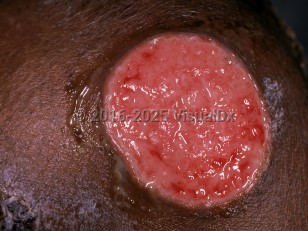Tertiary syphilis
Alerts and Notices
Important News & Links
Synopsis

Syphilis crisis in the United States: Syphilis and congenital syphilis cases have been surging nationwide, with an 80% increase in total syphilis cases between 2018 and 2022. Serologic testing is the primary means of diagnosing, staging, and managing syphilis. Testing should be done for any sexually active patient in whom syphilis is suspected or who has new, unexplained symptoms. Prompt diagnosis and treatment of syphilis can prevent systemic complications, including ocular involvement and permanent blindness.
Syphilis is a chronic systemic disease with multiple clinical presentations, caused by the spirochete Treponema pallidum. Disease is characterized by 3 stages of active disease (primary, secondary, and tertiary) interrupted by latent periods. Disease is acquired via intimate contact with infected lesions (usually sexual contact), by blood transfusion, or transplacentally to the fetus. After the advent of antibiotics, the long-term sequelae of infection with the treponeme (neurosyphilis, cardiovascular syphilis, and gummas) have become uncommon. In untreated syphilis, 15% of patients develop benign late syphilis with skin (70%), bone (10%), and/or mucous membranes (10%). About 16% of untreated patients will develop either neurosyphilis or cardiovascular syphilis.
Gummas are locally destructive lesions of skin, bone, or involved organs, which may heal spontaneously with scarring but often recur. The term "gumma" is derived from the appearance of slimy central necrotic tissue in ulcers. Skin lesions are usually asymptomatic. When the tongue is involved with an early glossitis, there may be discomfort eating hot or acidic foods. Bone lesions are painful. Symptoms of neurosyphilis may include headache, body aches, fatigue, weight loss, dizziness, paresis, behavior change, dementia, ataxia, blindness, deafness, incontinence, and impotence.
Systemic signs of tertiary disease include a heart murmur, aortitis, cranial nerve palsies, pupillary abnormalities (Argyll Robertson pupil), signs of tabes dorsalis, foot ulcers, and iritis. Syphilitic uveitis or other ocular syphilis manifestations (eg, neuroretinitis and optic neuritis) can occur at any stage of syphilis and can be isolated abnormalities or associated with neurosyphilis.
Tertiary, or late syphilis, occurs after a latent period of 2-20 years after infection. Damage to the skin, bones, and the central nervous (CNS) and cardiovascular systems is due to host delayed-type hypersensitivity reactions to a small number of organisms. An accelerated course and neurologic disease are observed more often in HIV infection, when disease progresses to the tertiary phase in months rather than years. Skin lesions endure for months to years untreated. If present, neurosyphilis or cardiovascular syphilis may result in death. Prognosis depends upon the duration and extent of disease.
Related topics: ocular syphilis, early congenital syphilis, late congenital syphilis
Syphilis is a chronic systemic disease with multiple clinical presentations, caused by the spirochete Treponema pallidum. Disease is characterized by 3 stages of active disease (primary, secondary, and tertiary) interrupted by latent periods. Disease is acquired via intimate contact with infected lesions (usually sexual contact), by blood transfusion, or transplacentally to the fetus. After the advent of antibiotics, the long-term sequelae of infection with the treponeme (neurosyphilis, cardiovascular syphilis, and gummas) have become uncommon. In untreated syphilis, 15% of patients develop benign late syphilis with skin (70%), bone (10%), and/or mucous membranes (10%). About 16% of untreated patients will develop either neurosyphilis or cardiovascular syphilis.
Gummas are locally destructive lesions of skin, bone, or involved organs, which may heal spontaneously with scarring but often recur. The term "gumma" is derived from the appearance of slimy central necrotic tissue in ulcers. Skin lesions are usually asymptomatic. When the tongue is involved with an early glossitis, there may be discomfort eating hot or acidic foods. Bone lesions are painful. Symptoms of neurosyphilis may include headache, body aches, fatigue, weight loss, dizziness, paresis, behavior change, dementia, ataxia, blindness, deafness, incontinence, and impotence.
Systemic signs of tertiary disease include a heart murmur, aortitis, cranial nerve palsies, pupillary abnormalities (Argyll Robertson pupil), signs of tabes dorsalis, foot ulcers, and iritis. Syphilitic uveitis or other ocular syphilis manifestations (eg, neuroretinitis and optic neuritis) can occur at any stage of syphilis and can be isolated abnormalities or associated with neurosyphilis.
Tertiary, or late syphilis, occurs after a latent period of 2-20 years after infection. Damage to the skin, bones, and the central nervous (CNS) and cardiovascular systems is due to host delayed-type hypersensitivity reactions to a small number of organisms. An accelerated course and neurologic disease are observed more often in HIV infection, when disease progresses to the tertiary phase in months rather than years. Skin lesions endure for months to years untreated. If present, neurosyphilis or cardiovascular syphilis may result in death. Prognosis depends upon the duration and extent of disease.
Related topics: ocular syphilis, early congenital syphilis, late congenital syphilis
Codes
ICD10CM:
A52.9 – Late syphilis, unspecified
SNOMEDCT:
72083004 – Late syphilis
A52.9 – Late syphilis, unspecified
SNOMEDCT:
72083004 – Late syphilis
Look For
Subscription Required
Diagnostic Pearls
Subscription Required
Differential Diagnosis & Pitfalls

To perform a comparison, select diagnoses from the classic differential
Subscription Required
Best Tests
Subscription Required
Management Pearls
Subscription Required
Therapy
Subscription Required
References
Subscription Required
Last Reviewed:09/02/2020
Last Updated:04/03/2024
Last Updated:04/03/2024
Tertiary syphilis

